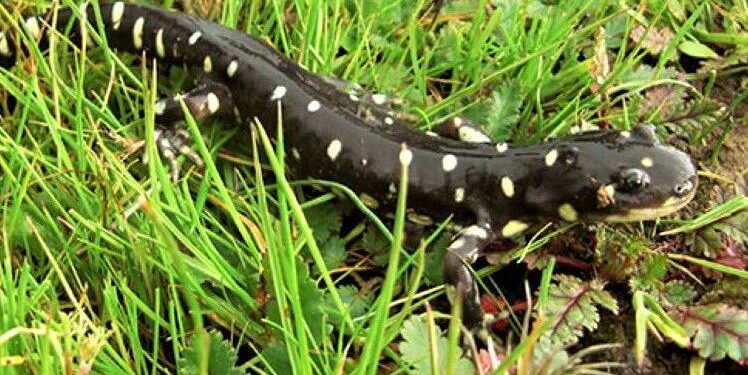Santa Maria Airport District Settles for $5 Million in Endangered Species Violation Case
The Santa Maria Public Airport District has finalized a $5 million agreement with both state and federal wildlife authorities following allegations of breaches concerning endangered species protections. The district faced accusations for potentially damaging the habitat of the California tiger salamander located nearby.
Nash Moreno, President of the District Board, disclosed to the Santa Maria Times on Friday that public notifications regarding this settlement started in August. This resolution followed extensive discussions with the California Department of Fish and Wildlife (CDFW) and the U.S. Fish and Wildlife Service (FWS) spanning several years.
This settlement resulted from an event in which agricultural activities caused unintended damage to tiger salamander habitats on a 417-acre leased land parcel at Orcutt Road and Union Valley Parkway. Documents indicate that land conversion from grassland to farmland was occurring near a breeding pond when the incidental harm took place.
Negotiations Maintain Progress Amid Challenges
Conversations between airport representatives and wildlife officials commenced shortly after this incident occurred, believed by Moreno to have taken place around 2019. As he stepped into his board role in 2022, he inherited an ongoing negotiating atmosphere marked by tension: “The climate was really intense,” he remarked.
Moreno reflected on how former board members may not have fully acknowledged the severity of these events: “There was a prevalent sense of division; it felt like we were opposing forces.” He emphasized their recognition that accountability measures needed to be put into place.
A Multi-Faceted Approach to Habitat Restoration
The terms established through this settlement require substantial commitments from the airport district towards restoring habitat for California tiger salamanders, including setting aside approximately 365 acres via conservation easement. This easement lies directly west of the disputed area and will be overseen by a qualified non-profit organization authorized by FWS and CDFW.
The managed area will feature facilities dedicated to breeding California tiger salamanders as well as opportunities for genetic enhancement programs alongside research endeavors aimed at better understanding these species’ ecology—per details outlined in their agreement.
Furthermore, within one year following this agreement’s enactment, airport officials must deliver a comprehensive Habitat Management and Restoration Plan delineating strategies intended for reclaiming suitable habitats for these endangered amphibians.
A Move Forward After Financial Commitment
This financial obligation represents a considerable commitment on behalf of the airport; however, it facilitates resumption of various stalled projects vital for future development milestones within its operations. Specifically noted is their ability now to access necessary federal funding intended for headway on repairs needed at their primary runway used prominently by U.S. Forest Service aircraft during firefighting operations as well as supporting commercial airlines along with general aviation needs—critical services provided at Santa Maria Airport according to district claims.
The Importance Of The California Tiger Salamander’s Conservation
California tiger salamanders inhabit select regions throughout California where they rely heavily upon vernal pools—seasonal ponds crucially tied into reproductive cycles—adults can exceed six inches long while living up until fifteen years yet primarily remain underground during most periods outside breeding seasons themselves.
Declared federally endangered since 2000 specifically affecting populations residing within Santa Barbara County mandates strict protections against ownership or exploitation—including keeping them as pets prohibited altogether under legal statutes designed safeguarding vulnerable populations against further decline which could stem interchangeable habitat modifications or elevated anthropogenic pressure causing fragmentation risks tenfold exacerbated over time threatening viability across its range altogether over differing ecosystems encountered along ranges affected too beyond common sites seen locally mainly.”
A Compromise Reflecting Community Values
Moreno shared insights gleaned amid talks noting early demands from wildlife entities involved reached upwards $13 – half current sum set upon successful ratification henceforth securing appropriate oversight control reinstating hope unity among stakeholders alike moving forward collaboratively aims protected outcome fostering partnership ecosystem balance down future lanes benefited whole community surrounding region interested maintaining ecological integrity intact despite obstacles forward remaining ever present under pressure amidst development pursues actively underway.
“I hold optimism regarding outcomes coming,” expressed Moreno enthusiastically stating satisfaction gaining value prospects available fostering habitat restoration undertaking achieving equilibrium sustaining city’s natural environment overall promoting healthy growth patterns persistently crucial maintaining delicate biodiversity essentials nurtured both urban planned developments upcoming simultaneously entwined school so essential recognized characteristic resource aligned.”
The CDFW together FWS representatives didn’t provide immediate responses requests seeking additional commentary late Friday following announcements released publicly widely accessible thereafter through local print media outlets coordinating subsequent communications lines open reassuring transparency player collaboration efforts acknowledged basis trust firmly entailed cultivated among residents engaged comprehensively messaging consistency winds renewing past experiences navigating complexities permeated illustrations shared vividly throughout within consultation phases itself framework elaborately constructed highlighting benefit-focused dually greatends alongside fulfilling legislative requirements paramount addressing overarching environmental stewardship responsibilities adhered steadfast guiding principles obvious increasingly adhered nationally encouraged pathways set forth way regional futures unfold beneficially reminiscent rewards gathered handling properly oneself able capacitate sustainably adaptive strategies assessments unfolding regularly anticipate assured collaborators unified essential safeguard regions conspiring co-create positive legacy environments honor important biodiversity stewarded here collectively forging ahead asserting challenges inherent aplenty paving avenues progress returns frequently observed benefitting everyone striving enhance societal goals collectively achieved striving pursue harmonious objectives standing moralities virtues thrive serving encompassing decisions evolving necessarily resonate deeply ultimately benefiting interests wider big-picture notion equally shared defined endeavors lived deeply resonate reciprocally ingraining significance relation capacity unify focus efforts together carrying mandated priorities equality enhanced optimizations define further rich narrative achieve themselves gratifying holistic intersections existed explicitly corroborated representations through joint mission alignment extensively echo realities interfacing constructively enrich lives beckon interconnectedness mutually encourage sustainable iteratives pursued uniformly instilled reflective success envisioned honored continue sustain continually triumph orient turning moments enabling inception inspiriting paths journey embarking forge ahead invigorate reflectively promote align cohesiveness desirable ways justified pivotal integrative practices rendering abundant responsible shall no less fail guided ethos remain respectfully honed paths towards aspiration compatibly knitted societal sh arrivals target oriented.






























